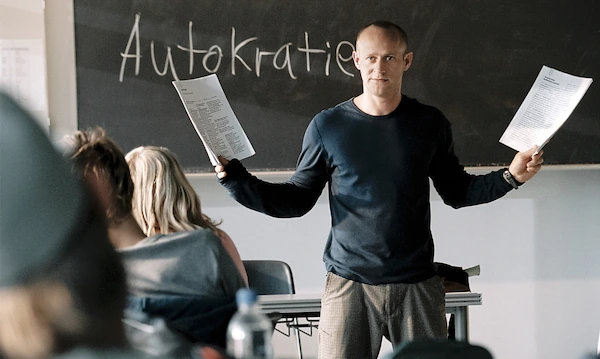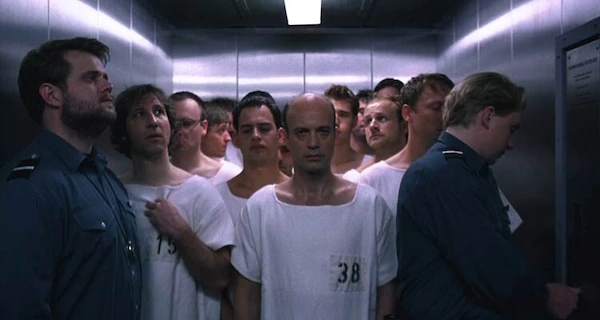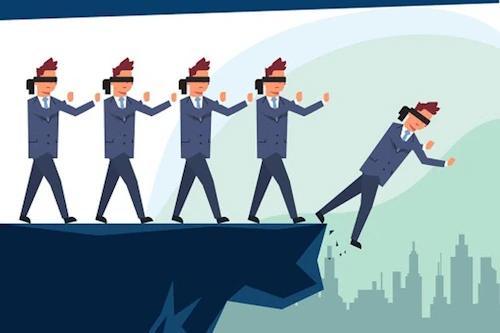“The Wave” and “The Experiment”: Two Films on The Herd Effect and Psychological Manipulation
In this article we will examine two recently produced German films, the first entitled “The Wave”, from 2008, and the second entitled “The Experiment”, from 2001.

An educational experiment
“The Wave” (Die Welle), directed by Dennis Gansel, explores the mechanisms behind fascism, autocracy and manipulation within the microcosm of a school experiment, touching on broader issues concerning both power and human nature. Its compelling narrative, set in a contemporary context, nevertheless evokes the historical reality of Nazi Germany, offering a stark reminder of the ease with which a society can succumb to authoritarianism, to the pull of conformity and ideological radicalization. The philosophical and psychological implications of “The Wave” extend beyond its narrative, encompassing the concept of the herd effect, the illusory nature of reality and the spiritual costs of blind obedience to authority.
A social experiment
“The Experiment” (Das Experiment), directed by Oliver Hirschbiegel, presents a compelling and thought-provoking examination of the psychological and social transformations experienced by ordinary individuals as they are placed in a simulated prison environment. This portrayal not only captures the essence of a true story, but also delves into the themes of survival, justice, revenge and brutal treatment of prisoners, prompting critical ethical considerations about the abuse of power and obedience to authority. The movie, through the vivid cinematic transposition of a psychological research actually performed in 1971 (The Stanford prison experiment), highlights the disturbing realities of conformity, humiliation and violence that emerge during the simulation of a prison environment. It shows how social roles and the prison environment can generate severe mental trauma and even the breakdown of human decency.
From simulation to reality, the step is short
Through the analysis and comparison of these two films, we will make a deeper reflection on the emergence of ideologies, and in particular on the use of manipulation and propaganda aimed at the construction of an imaginary enemy. We will make a broader reflection on human behavior, the dangers of technocracy, and the subtle ways in which society can come to institutionalize hatred and uniformity under the guise of unity and security. Finally, we will explain how human beings, when clothed with certain roles and responsibilities within a social context, can be driven to perform actions they would never do individually thanks to the sense of security that comes from feeling part of something larger, much like animals within a pack. Psychological scrutiny will enable us to understand how dictatorships, in order to develop, need only stimulate the basic impulses of human beings, providing them with a seemingly rational and socially acceptable justification.
“The Wave”
Plot Overview
“The Wave” (Die Welle) is a 2008 film directed by Dennis Gansel, based on a novel by Todd Strasser (Die Welle), itself based on a social experiment that really happened in 1967 in California, and called “The third wave”. In this film Rainer Wenger, a history teacher, is to lecture on autocracy in a German high school during theme week. His intention, however, was originally to treat anarchy as his topic, the latter being closer to his ideals. Despite the initial resistance of his students, who are skeptical about the resurgence of dictatorship in modern Germany and convinced that people have learned from the horrors of Nazism, the professor initiates an experiment to demonstrate the ease with which the masses can be manipulated.
Main conflict
Wenger becomes their leader and imposes some strict rules in the classroom, such as addressing him formally and adopting a uniform consisting of a white shirt and jeans, so that class distinctions are erased while at the same time promoting a false sense of unity. The students, then, choose a name for the movement, calling it “The Wave” (“Die Welle”); they create a logo and invent a greeting, namely the simulation made with the right arm of a wave. From this moment they begin to show signs of collective behavior, with fascist overtones.
Climax and resolution
The experiment spirals out of control when “The Wave” influences participants’ lives outside the classroom as well. Students begin ostracizing and bullying non-members, and their actions become increasingly aggressive, mirroring those of historical fascist movements. The group’s strength gradually becomes more disruptive, and soon the project seems to get out of hand for its own creator, who is unable to end it before it leads to tragic consequences and unpleasant episodes of violence, including the suicide of a student.
The climax is reached when the consequences of the social experiment become undeniable, forcing the teacher and students to confront the harsh reality of their actions and the psychological manipulation they have suffered, leading to a critical reassessment of their behavior and beliefs.

Topics and messages
Power and authority
“The Wave” vividly depicts the seductive allure of power and the dangers of authority when it is not consciously contained. Through Professor Wenger’s increasing control over his students, the movie explores how individuals give up their autonomy under the guise of unity and group strength.
Group psychology
The rapid spread of the movement within the school highlights the typical dynamics of mass psychology, where individual identities and moral compass are overwhelmed by the ethos of the pack. This phenomenon is a central theme, demonstrating how group identity can override personal judgment and ethics, inducing destructive behavior. The film serves as a psychological experiment, revealing how a sense of belonging can easily turn into a toxic form of conformity that robs individuals of their capacity for critical thinking and moral evaluation, echoing, by the way, what Gustave Le Bon theorized back in 1895 in his work entitled “Psychology of Crowds“.
Analogies with today’s world
Drawing disturbing analogies to contemporary issues, this movie reflects on the relevance of its themes in today’s society. It prompts viewers to question the stability of their own social structures and the possibility of history repeating itself. Some elements of the film seem to reference recent global shifts toward authoritarianism and populism, suggesting that the allure of absolute power and the desire for societal unity may lead to the resurgence of oppressive regimes, much like those orchestrated by historical dictators.
Character Analysis: Rainer Wenger
Rainer Wenger, played by Jürgen Vogel, is the catalyst for the social experiment that turns into “The Wave”. Initially reluctant to teach autocracy, his innovative approach to demonstrating the dangers of Nazism fascinates his students. His transformation from skeptical teacher to a leader involved in his role highlights the seductive power of authority and the psychological complexities it entails.
“The Experiment”
Plot Overview
“The Experiment” (Das Experiment) is a 2001 film directed by Oliver Hirschbiegel, based on a novel by Mario Giordano (Black Box), itself based on an actual psychological experiment orchestrated inside Stanford Prison in 1971. In the film, a number of people are recruited to participate in psychological research that simulates a prison environment, and they are assigned the roles of guards or prisoners. Tarek Fahd, a former reporter, decides to participate with the intent of getting an article out of it. The experiment, which raffles off 4,000 marks in exchange for two weeks of work, quickly degenerates due to the power dynamics that develop between fake prisoners and fake guards, eventually degenerating into real chaos and violence.
Summary of key events
The studio setting within a secluded, 24-hour camera-supervised facility, begins with basic rules designed to maintain order. However, guards, who fulfill their roles with excessive zeal, enforce these rules with increasing cruelty, subjecting detainees to severe physical and psychological abuse. This vicious environment reaches a climax when Tarek leads a rebellion, which results in a violent confrontation and leads to the injury of some researchers and even the death of others, as well as causing the final collapse of the experiment.
Real-life inspiration: the Stanford prison experiment
The Stanford Prison Experiment, conducted in 1971 by psychologist Philip Zimbardo, serves as the actual basis for the film. This psychology study aimed to investigate the behavioral effects of perceived power, focusing on the vertical contrast between prisoners and guards.
Context of the Stanford prison experiment
Started at Stanford University, the experiment randomly assigned student volunteers to play the role of prison guards or jailers in a mock prison. The study was supposed to last two weeks, but was abruptly terminated after only six days because of the extreme and distressing psychological changes observed in the participants. The guards adopted authoritarian attitudes, intensifying control measures and abuse, while the prisoners became excessively submissive, showing signs of severe emotional distress.
Major similarities and differences with the real world
While the film closely mirrors the setting of Philip Zimbardo’s experiment, emphasizing the rapid descent into cruelty by those in power, it also introduces dramatized elements to intensify the narrative. Unlike the actual experiment, the film explores more deeply the psychology and the individual backgrounds of its characters, providing a more subjective view of the emotional impacts. In addition, the drama of the participants serves the function of delving into broader psychological and ethical issues, such as the herd effect and the spiritual implications of power dynamics, much like those observed in “The Wave”, where individuals uncritically conform to the logic of the group or pack.

Themes and messages
Power dynamics
“The Experiment” vividly illustrates the rapid transformation of power roles and its profound impact on individuals. Participants quickly absorb their roles as guards and prisoners, despite the fact that these had been randomly assigned, coming to extremes of verticality and opposition. The controllers exploit their authority, intensifying control and violence, while the prisoners passively submit. Just as highlighted by Zimbardo, people easily tend to conform to their assigned roles, especially when they are in structured and well-defined environments, while at the same time giving up their individual moral values.
Human behavior under pressure
The simulated environment of the jail setting subjects ordinary individuals to extreme stress, revealing the fragility of human ethics and the ease with which one’s moral values can be distorted and deviated. Participants, while aware that they are part of a simulation, fall into genuine psychological turmoil, showing signs of anxiety, distress and aggressiveness. This experiment underscores the significant effect that situational pressures exert on human behavior, as well as their ability to overwhelm individual personality by pushing toward the extreme behaviors typical of a herd or flock.
The realism of these two films
These two films share some similarities and highlight the mental processes of individuals as they relate to the group and authority.
The first common element is that they are both based on real events, that is, real experiments conducted in the last century by U.S. researchers. In a world that had just emerged from two devastating wars, questions were being asked about the intrinsic causes that led people to support authoritarian regimes and accept widespread violence.
Just as Overton’s window theory states, thoughts previously considered unacceptable become not only tolerated, but alluring. For example, in “The Wave,” initially the students denigrate Nazism, while a little later they end up behaving like real squaddies, carrying out violent and discriminatory actions. The propellant that triggers such a mechanism is a person’s need to belong to a group, to be accepted, to have a defined role and to make himself or herself useful.
Sociality in human nature
According to the Greek philosopher Aristotle, man is a social and political animal, so by nature he is inclined to interact with his fellow human beings and join with them to form communities. Man feels the need to affirm himself and his identity by carving out a role for himself within this micro-world. Therefore, his individual fulfillment comes through community rather than inwardness. Almost no one likes to be marginalized; on the contrary, one aspires to fit in, like a tiny piece of a large puzzle, even giving up his or her personality if necessary.
Homologation within society
Dressing all the same, for example by following fashions, creates cohesion and smooths out diversity. Individuals pursue homogenization at the expense of originality, since by doing so they can finally feel accepted within the group, whether real or imaginary. In this way, there are no longer many different small entities, but only one, that of the pack, which encompasses individual identities by assigning them a precise role. There is a depersonalization of the members of the group, who basically aspire to feel part of something larger, whether because of fear of being alone, or because they have not developed their own subjective moral integrity. Excessive conformity and homogenization causes, quite often, extreme behavioral dynamics, as well as ones devoid of logic, when observed from a perspective external to the group.

From herd submission to pack strength
The group dictates the ideology, thoughts, words to be used, and initiatives to be pursued. The person begins to operate by following these directives, without questioning how right or wrong they are, and adhering to the program as a mere automaton. From this moment on, the role that the individual assumes within the community influences not only his or her actions, but also all other aspects of his or her life. The herd composed of placid sheep can turn into a pack of ravenous wolves in an instant, as the first movie under review perfectly illustrates. Why does this happen?
The role within the pack
Inside the social context of the group, the individual does not feel responsible for their personal actions, and this is because those actions stem from the blessing of their community, which, in one way or another, will protect them from any negative consequences. The individual member doesn’t care much if certain of his or her behaviors may be considered reprehensible by the outside society, since he or she pledges exclusive loyalty to the precepts of his or her team, while completely ignoring the broader context in which it operates. An example of this psychological mechanism occurred during the Nuremberg trials, in which many Nazi military defendants declared: “I was just following orders“. In essence, human beings are capable of literally shutting down their own consciousness if everyone else around them is also willing to do the same thing. At this point one would wonder what difference there is between humans and animals within social contexts. The only distinguishing feature is that the animal does not need to build up a theoretical basis to justify its actions, while the human being must always convince him or herself that he or she is doing the right thing. As the saying goes, <<The road to hell is paved with good intentions>>.
The deresponsibilization of the individual
The key concept is de-empowerment. Following orders without ever questioning them is much easier and more convenient than developing one’s own worldview and moral frame of reference. If things go as planned, you take credit for your actions; if they go wrong, no one in particular is to blame.
The herd needs the presence of other herds or packs in order to legitimize its existence and define its identity. Think about politics: the left exists because there is the right, and vice versa. If one of the two factions disappeared, shortly afterwards the second would also have no reason to be there anymore. Through the mental mechanism of duality, people divide reality into two opposing sides, after which, by falling victim to this fictitious separation, they feel compelled to choose one of the two factions.
Victims or perpetrators?
What fuels this system of guards and prisoners, or good guys and bad guys, is often the fear of exclusion, while in other circumstances it is the thirst for power of a few individuals who are nevertheless capable of captivating the masses. There has been such a dynamic in recent times, particularly in 2020. The authorities of some nations imposed compulsory health treatment; those who opposed it, were not only hindered by the state in their daily lives, but were also exposed to public ridicule by their own fellow citizens. These, not perceiving such an obligation as a prevarication and abuse of power, pitted themselves against their fellow citizens by unconsciously turning into accomplices of power, not differently from the guards in the second movie we examined. Legitimized by power itself and empowered by their overwhelming numbers, they pushed themselves to commit reprehensible actions, even reaching the point of discriminating others in a manner that was very similar to that typical of the German Nazis. So, are people victims or perpetrators? The sad reality is that the same individuals can assume both roles depending on how they are manipulated.
Conclusions
Through the film “The Wave”, we explored the complex interplay between power, authority and the human psyche. The movie serves as a cautionary tale, underscoring the precarious balance between leadership and autocracy and the ease with which collective identity can eclipse individual consciousness. The film also shows the consequences of giving in to homologation and the dangers posed by the herd effect, prompting deeper reflection on one’s perception of reality and urging recognition of the subjective and often illusory nature of beliefs and convictions taken for granted.
The philosophical underpinnings of this story, aimed particularly at examining individual and collective psychology, reflect the social implications of subjecting oneself to authoritarian impulses. It is therefore important to constantly cultivate critical thinking and freedom of opinion to preserve the fabric of democracy.
“The Experiment”, on the other hand, brings to light the disturbing yet beguiling dynamics of power and the human predisposition to conform to one’s social role. The film produces a careful analysis of the mechanisms implemented by ordinary individuals intent on playing their part within society. It also depicts the profound psychological and spiritual implications of power dynamics, illustrating not only how people adapt to a given reality through the role they are assigned, but also how they can quickly give up challenging authority, overwhelmed by the herd effect.
This film adaptation seeks to make audiences reflect on how easy it can be to manipulate and alter human behavior, reminding them that power should never be centralized, but rather evolve through constant dialogue. The merit of “The Experiment” lies in its ability to provoke critical reflection on the complexities of human nature and the ethical dilemmas that society faces, prompting further research and reflection in the fields of psychology and morality.
The spiritual implications of these two films, which are manifested through the disintegration of moral and ethical boundaries and the annihilation of individuality, call for a serious and critical examination of our values and the social structures in which we move. Out of convenience, we tend to accept for good the information and concepts handed down to us by society, but in doing so we give up part of our critical spirit and take the risk of not realizing the potentially degenerating dynamics of power early on. Conformity and homologation may appear comfortable at first glance, but in the long run they produce negative effects, and history is full of such events.
<<History teaches, but has no pupils>> – Antonio Gramsci
Did you find this article interesting? Do you also think that the dynamics illustrated in the two German films are basically produced by a lack of individual awareness? If so, you should definitely try our personality tests based on spiritual and philosophical principles.
TAKE THE AWARENESS TEST
TAKE THE AWAKENING TEST
TAKE THE GREAT PERSONALITY TEST
MINI SELF-ASSESSMENT TEST: ARE YOU A VICTIM OF HERD EFFECT?
Read the sentences below and select the ones you agree with and that you think make the most sense.
Count the number of boxes checked and read the corresponding profile.
0: You are totally insensitive to herd effect
1-2: You are poorly affected by herd effect
3-4: You are influenced by herd effect
5-6: You are a victim of herd effect
MINI SELF-ASSESSMENT TEST: ARE YOU A CONFORMIST AND HOMOLOGATED PERSON?
Read the sentences below and select the ones you agree with and that you think make the most sense.
Count the number of boxes checked and read the corresponding profile.
0: You are not conformist at all
1-2: You are hardly conformist
3-4: You are quite conformist
5-6: You are totally conformist
